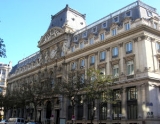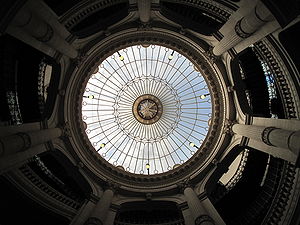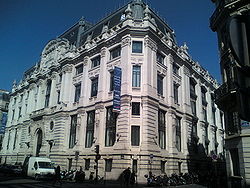
Crédit Lyonnais headquarters
Encyclopedia
.jpg)
.jpg)
Crédit Lyonnais
Crédit Lyonnais is a historic French bank. In the early 1990s it was the largest French bank, majority state-owned at that point. Crédit Lyonnais was the subject of poor management during that period which almost led to its bankruptcy in 1993...
, now LCL
LCL
LCL can mean:* Labor Contract Law, a 2008 Chinese law intended to protect workers* Lateral collateral ligament, a ligament found on the outside apect of the knee* Lazarus Component Library, the Lazarus GUI subsystem, similar to Borland VCL...
) is installed in a haussmannian style
Haussmann's renovation of Paris
Haussmann's Renovation of Paris, or the Haussmann Plan, was a modernization program of Paris commissioned by Napoléon III and led by the Seine prefect, Baron Georges-Eugène Haussmann, between 1853 and 1870...
building in the 2nd arrondissement of Paris. It is located on a quadrilateral formed by the Boulevard des Italiens
Boulevard des Italiens
The boulevard des Italiens is one of the four 'grands boulevards' in Paris, a chain running east west and also including boulevard de la Madeleine, Boulevard des Capucines and boulevard Montmartre...
, the rue de Gramont, the rue du Quatre-Septembre and the rue de Choiseul.
Construction

- 1863: Foundation of the Credit Lyonnais in the French town of LyonLyonLyon , is a city in east-central France in the Rhône-Alpes region, situated between Paris and Marseille. Lyon is located at from Paris, from Marseille, from Geneva, from Turin, and from Barcelona. The residents of the city are called Lyonnais....
.
- 1876 - 1883: Construction of the main branch in Paris. A block of 1,590 m2 was purchased in Paris. Then, the hotel Boufflers-Rouvenel was demolished to make way for the headquarters of Credit Lyonnais, designed by the architect William Bouwens van der Boijen. The building was built in the HaussmannianHaussmann's renovation of ParisHaussmann's Renovation of Paris, or the Haussmann Plan, was a modernization program of Paris commissioned by Napoléon III and led by the Seine prefect, Baron Georges-Eugène Haussmann, between 1853 and 1870...
style to impress customers and investors. The building was also planned so that it could be converted into a department store in case of bankruptcy.
- 21 March 1878: Building inaugurated in the presence of Léon GambettaLéon GambettaLéon Gambetta was a French statesman prominent after the Franco-Prussian War.-Youth and education:He is said to have inherited his vigour and eloquence from his father, a Genovese grocer who had married a Frenchwoman named Massabie. At the age of fifteen, Gambetta lost the sight of his right eye...
, at that time director of the Budget Committee of the National Assembly.
The building is organized around a large double helix similar to the one in Chateau de Chambord
Château de Chambord
The royal Château de Chambord at Chambord, Loir-et-Cher, France is one of the most recognizable châteaux in the world because of its very distinct French Renaissance architecture which blends traditional French medieval forms with classical Renaissance structures.The building, which was never...
. The building was a real success : it was necessary to deliver "permission to visit" tickets !
- 1882 : Official transfer of Crédit Lyonnais's headquarters from LyonLyonLyon , is a city in east-central France in the Rhône-Alpes region, situated between Paris and Marseille. Lyon is located at from Paris, from Marseille, from Geneva, from Turin, and from Barcelona. The residents of the city are called Lyonnais....
(where the bank was founded) to Paris.
- 1913: Completion of construction by the architect Victor LalouxVictor LalouxVictor Alexandre Frederic Laloux was a French Beaux-Arts architect and teacher.- Life :Born in Tours, Laloux studied at the Paris École des Beaux-Arts atelier of Louis-Jules André, with his studies interrupted by the Franco-Prussian War, and was awarded the annual Prix de Rome in 1878...
. The building was gradually extended to the whole quadrilateral between the Boulevard des Italiens, the rue de Choiseul, rue du Quatre Septembre and rue de Gramont.
Structure of the building

Gustave Eiffel
Alexandre Gustave Eiffel was a French structural engineer from the École Centrale Paris, an architect, an entrepreneur and a specialist of metallic structures...
.
The office space is organized on several levels, from both sides of a gallery lightened through a glass: the whole offices are visible by the public and the management.
A hall is located at each end of the building, each lit by a glass at 21 metres height achieved by the workshop of Gustave Eiffel. The glass on the side of the boulevard of the Italians is more impressive than the side of the rue du Quatre-Septembre. It hosts in the floors the offices of the General Staff of the bank.
The Hall of securities at the time was designed as the frame, like a hall metal by institutions Eiffel.
On the outside, on the Boulevard des Italiens, the central pavilion is based on Pavillon de l’Horloge
Pavillon de l’Horloge
The Pavillon de l’Horloge is a prominent element of the Palais du Louvre in Paris. It was built between 1624 and 1654 under King Louis XIV. The famous structure, with its distinctive domed roof, was designed by architect Jacques Lemercier . It is adjacent to the famous Lescot Wing...
of the Palais du Louvre
Palais du Louvre
The Louvre Palace , on the Right Bank of the Seine in Paris, is a former royal palace situated between the Tuileries Gardens and the church of Saint-Germain l'Auxerrois...
. The pediment, carved by Camille Lefèvre
Camille Lefèvre
Camille Lefèvre was a French sculptor.- Biography :Born in Issy-les-Moulineaux, in 1870 Lefèvre became a pupil of Jules Cavelier at the Ecole des Beaux-Arts in Paris. In 1878, he won the second Prix de Rome in sculpture. In 1893 he exhibited at the Chicago World Fair...
, is an allegory of banking activities: it represents the bank distributing loans, surrounded by the Trade and Industry, and the rivers Rhone and the Seine. It is supported by four groups of caryatid
Caryatid
A caryatid is a sculpted female figure serving as an architectural support taking the place of a column or a pillar supporting an entablature on her head. The Greek term karyatides literally means "maidens of Karyai", an ancient town of Peloponnese...
s around a large clock by sculptor Désiré-Maurice Ferrary.
When it opened, the building housed one of the first electrical installations. To provide light to the room of safes, a part of the floor was composed of glass tiles manufactured by Saint-Gobain.
To impress people and encourage them to cross the building, a huge hall, lit by 310 gas burners, opened between rows of desks in the English fashion, without grids or windows. In the same spirit of open space
Public space
A public space is a social space such as a town square that is open and accessible to all, regardless of gender, race, ethnicity, age or socio-economic level. One of the earliest examples of public spaces are commons. For example, no fees or paid tickets are required for entry, nor are the entrants...
, the offices were not separated. "Bulkheads are only used by employees to read freely their newspapers!" said Henri Germain. For the management, at the first floor, the doors were with mahogany paneling and draperies of green reps. The securities service moved first from Lyon to Paris. Vouchers were kept in 195 safes Fichet in the basement, surrounded by a walkway and serviced by a staircase at the top where an ashtray is marked "Turn off your cigars."
The double revolution staircase
Inside the building, there is a double revolution staircase (or double helix staircase), which is famous. It was inspired by the staircase of the Chateau de ChambordChâteau de Chambord
The royal Château de Chambord at Chambord, Loir-et-Cher, France is one of the most recognizable châteaux in the world because of its very distinct French Renaissance architecture which blends traditional French medieval forms with classical Renaissance structures.The building, which was never...
. Both have the same goal: allow two populations to use the same stairs without meeting each other; there was a stair (with dual balustrade) for the management, and another (with single balustrade) by employees.
The stairs continue with metal stairs from the second floor and the fourth, but still in double revolution. The use of metal is characteristic of the industrial era. A glass roof, 30 metres above the ground, illuminates the entire staircase.
Some offices are accessible via classic stairs at the 5th floor and even at the 6th floor in the main pavilion located above the entrance of the Boulevard des Italiens.
Ulterior evolutions
- 1957: A proposal to construct a high-rise tower block of 20 floors within the old building is rejected Facilities of heating, lighting and ventilation are modernised.
- Early 1970s: Complete renovation in the spirit of that time, with the goal to locate more employees on the site. The first data processing systems are installed. The securities hall, built by Eiffel, is demolished and the space used for offices. The offices of the ground floor no longer have windows, while those on the upper floors are organized around a small atriumAtrium (architecture)In modern architecture, an atrium is a large open space, often several stories high and having a glazed roof and/or large windows, often situated within a larger multistory building and often located immediately beyond the main entrance doors...
that will play a terrible role in the subsequent fire.
- 14 May 1976: The chairman of Crédit Lyonnais, Jacques Chaine is murdered by a deranged gunman at the entrance to the building.
- April 1996 - A large part of the French film Le cri de la soie is shot in the hall on the side of rue du Quatre-Septembre. The movie was set in a department store.
The fire on Sunday 5 May 1996
Source :- 8:24 : A monitor reports a fire in the trading room.
- 8:26 : Two security officers go to the scene, firefighters are called.
- 8:32 : Twenty firefighters from the saint-Honoré barracks arrive at rue de Choiseul. Doors are unlocked to let them enter and fight the fire.
- 9:15 : Fire spreads rapidly in the trading room, a large space with no partitions or fire doors (to allow traders to communicate freely). More than a hundred firefighters are on site.
- 9:41 : message about the fire released by Agence France-PresseAgence France-PresseAgence France-Presse is a French news agency, the oldest one in the world, and one of the three largest with Associated Press and Reuters. It is also the largest French news agency. Currently, its CEO is Emmanuel Hoog and its news director Philippe Massonnet...
. - 11 am : The fire in the trading room seems under control.
- 11h20 : The slab of garden located above the trading room collapses : a huge blast effect creates multiple outbreaks of fire.
600 firefighters were mobilized and spent about 19 hours extinguishing the fire. Two thirds of the building located on the side of rue du Quatre-Septembre were devastated. The room safe was partially flooded.
After the fire
After the fire which caused enormous damage, the Credit Lyonnais sells his headquarters for 1.3 billion francs to the insurer AIG.
After the fire, the building is divided in two separate spaces. Credit Lyonnais keeps the historic part called "Hotel des Italiens", about a quarter of the building on the side of the boulevard des Italiens. With the offices of the direction, the council room and the double revolution staircase.
The part of the building on the side of the rue du Quatre-Septembre has suffered hard damages. It was renamed "Centorial", in particular to reuse the logo CL on the facade.
- Summer 2008 : At request of the architect of French buildings, relocation of a large lead piece at the top of the main entrance. It has been removed during restorations in the 1950s. It is a decorative piece with the escutcheon of the town of Lyon, where the Credit Lyonnais was founded.
Its features are impressive: 4.30 m wide and 3.50 m high at 36 m height. Weight: 4 tons. It was created by Jean-Claude Duplessis, ornementist and best worker of France.
Centorial


The trading room (where the fire broke out) and the hanging garden situated above it were replaced by a long gallery with a metal canopy that remember the securities hall of the original building.
In 2005, the employees of the French economic newspaper Les Échos left rue de la Boétie and moved into the building. Some departments of LCL (new name of Credit Lyonnais) were also installed in the building.
Centorial website
http://www.lecentorial.com/page.htm http://www.lecentorial.fr/architecture.htmAnecdote
- The wall of rue de Choiseul near the corner with the rue du Quatre Septembre shows traces of a German "plane bomb" exploded on 30 January 1918.

